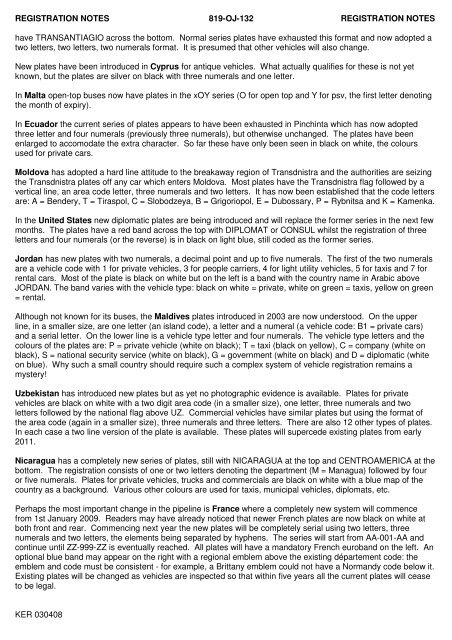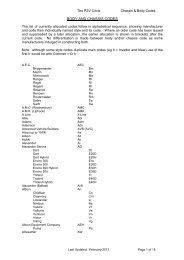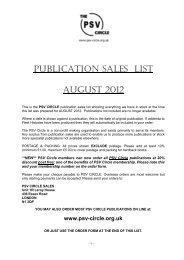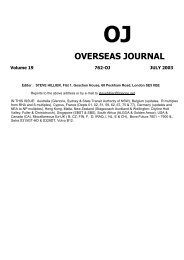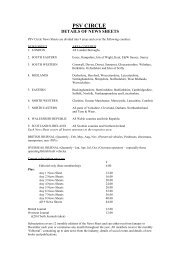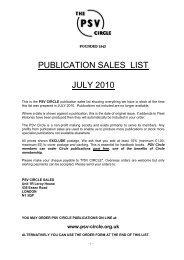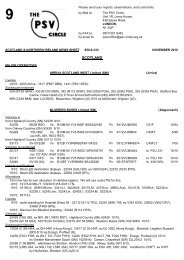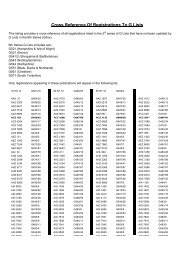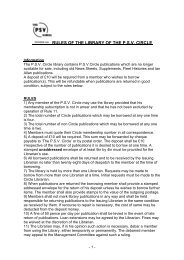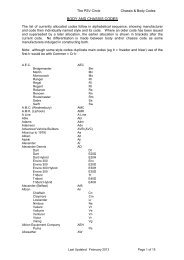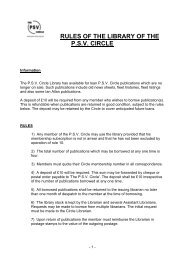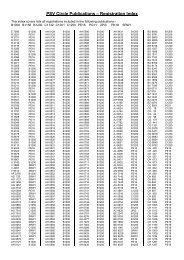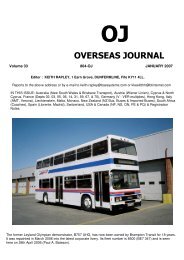oj overseas journal - The PSV Circle Website
oj overseas journal - The PSV Circle Website
oj overseas journal - The PSV Circle Website
Create successful ePaper yourself
Turn your PDF publications into a flip-book with our unique Google optimized e-Paper software.
REGISTRATION NOTES 819-OJ-132 REGISTRATION NOTES<br />
have TRANSANTIAGIO across the bottom. Normal series plates have exhausted this format and now adopted a<br />
two letters, two letters, two numerals format. It is presumed that other vehicles will also change.<br />
New plates have been introduced in Cyprus for antique vehicles. What actually qualifies for these is not yet<br />
known, but the plates are silver on black with three numerals and one letter.<br />
In Malta open-top buses now have plates in the xOY series (O for open top and Y for psv, the first letter denoting<br />
the month of expiry).<br />
In Ecuador the current series of plates appears to have been exhausted in Pinchinta which has now adopted<br />
three letter and four numerals (previously three numerals), but otherwise unchanged. <strong>The</strong> plates have been<br />
enlarged to accomodate the extra character. So far these have only been seen in black on white, the colours<br />
used for private cars.<br />
Moldova has adopted a hard line attitude to the breakaway region of Transdnistra and the authorities are seizing<br />
the Transdnistra plates off any car which enters Moldova. Most plates have the Transdnistra flag followed by a<br />
vertical line, an area code letter, three numerals and two letters. It has now been established that the code letters<br />
are: A = Bendery, T = Tiraspol, C = Slobodzeya, B = Grigoriopol, E = Dubossary, P = Rybnitsa and K = Kamenka.<br />
In the United States new diplomatic plates are being introduced and will replace the former series in the next few<br />
months. <strong>The</strong> plates have a red band across the top with DIPLOMAT or CONSUL whilst the registration of three<br />
letters and four numerals (or the reverse) is in black on light blue, still coded as the former series.<br />
Jordan has new plates with two numerals, a decimal point and up to five numerals. <strong>The</strong> first of the two numerals<br />
are a vehicle code with 1 for private vehicles, 3 for people carriers, 4 for light utility vehicles, 5 for taxis and 7 for<br />
rental cars. Most of the plate is black on white but on the left is a band with the country name in Arabic above<br />
JORDAN. <strong>The</strong> band varies with the vehicle type: black on white = private, white on green = taxis, yellow on green<br />
= rental.<br />
Although not known for its buses, the Maldives plates introduced in 2003 are now understood. On the upper<br />
line, in a smaller size, are one letter (an island code), a letter and a numeral (a vehicle code: B1 = private cars)<br />
and a serial letter. On the lower line is a vehicle type letter and four numerals. <strong>The</strong> vehicle type letters and the<br />
colours of the plates are: P = private vehicle (white on black); T = taxi (black on yellow), C = company (white on<br />
black), S = national security service (white on black), G = government (white on black) and D = diplomatic (white<br />
on blue). Why such a small country should require such a complex system of vehicle registration remains a<br />
mystery!<br />
Uzbekistan has introduced new plates but as yet no photographic evidence is available. Plates for private<br />
vehicles are black on white with a two digit area code (in a smaller size), one letter, three numerals and two<br />
letters followed by the national flag above UZ. Commercial vehicles have similar plates but using the format of<br />
the area code (again in a smaller size), three numerals and three letters. <strong>The</strong>re are also 12 other types of plates.<br />
In each case a two line version of the plate is available. <strong>The</strong>se plates will supercede existing plates from early<br />
2011.<br />
Nicaragua has a completely new series of plates, still with NICARAGUA at the top and CENTROAMERICA at the<br />
bottom. <strong>The</strong> registration consists of one or two letters denoting the department (M = Managua) followed by four<br />
or five numerals. Plates for private vehicles, trucks and commercials are black on white with a blue map of the<br />
country as a background. Various other colours are used for taxis, municipal vehicles, diplomats, etc.<br />
Perhaps the most important change in the pipeline is France where a completely new system will commence<br />
from 1st January 2009. Readers may have already noticed that newer French plates are now black on white at<br />
both front and rear. Commencing next year the new plates will be completely serial using two letters, three<br />
numerals and two letters, the elements being separated by hyphens. <strong>The</strong> series will start from AA-001-AA and<br />
continue until ZZ-999-ZZ is eventually reached. All plates will have a mandatory French euroband on the left. An<br />
optional blue band may appear on the right with a regional emblem above the existing département code: the<br />
emblem and code must be consistent - for example, a Brittany emblem could not have a Normandy code below it.<br />
Existing plates will be changed as vehicles are inspected so that within five years all the current plates will cease<br />
to be legal.<br />
KER 030408


